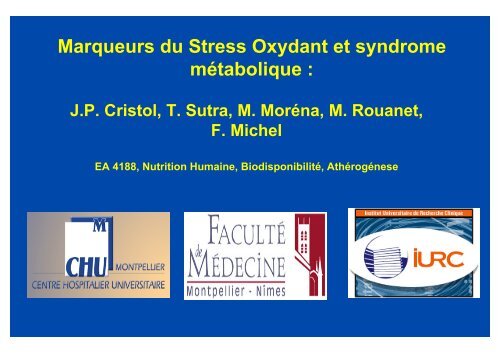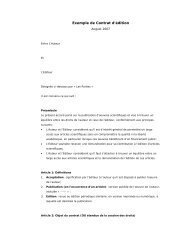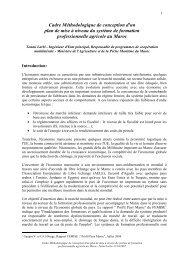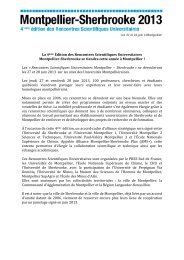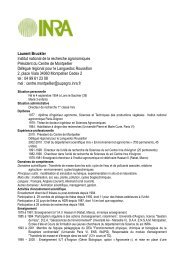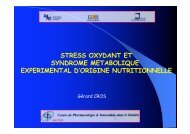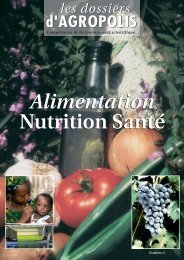Marqueurs du Stress Oxydant et syndrome métabolique :
Marqueurs du Stress Oxydant et syndrome métabolique :
Marqueurs du Stress Oxydant et syndrome métabolique :
Create successful ePaper yourself
Turn your PDF publications into a flip-book with our unique Google optimized e-Paper software.
<strong>Marqueurs</strong> <strong>du</strong> <strong>Stress</strong> <strong>Oxydant</strong> <strong>et</strong> <strong>syndrome</strong><br />
métabolique :<br />
J.P. Cristol, T. Sutra, M. Moréna, M. Rouan<strong>et</strong>,<br />
F. Michel<br />
EA 4188, Nutrition Humaine, Biodisponibilité, Athérogénese
Les marqueurs <strong>du</strong> <strong>Stress</strong> <strong>Oxydant</strong><br />
Antioxydants:<br />
SOD, GPx,<br />
Catalase, GSH,<br />
Vitamines E <strong>et</strong> C,<br />
● NO,<br />
Caroténoides<br />
<strong>Oxydant</strong>s:<br />
O 2<br />
● - , OH ● ,<br />
1<br />
O 2 , H 2 O 2 , ●<br />
NO, ONOO - ,<br />
HOCl, ROO ● ,<br />
ROOH<br />
Existe-t-il des marqueurs de pro<strong>du</strong>ction d’oxydant ?.<br />
Peut-on apprécier les mécanismes de défense ?<br />
Existe-t-il des marqueurs de déséquilibre ?
Pro<strong>du</strong>ction de radicaux libres :<br />
Un copro<strong>du</strong>it <strong>du</strong> métabolisme énergétique<br />
O 2 ° -<br />
Antioxydants<br />
Prooxydants
Concept <strong>du</strong> <strong>Stress</strong> <strong>Oxydant</strong> :<br />
rupture d’éd<br />
’équilibre <strong>et</strong> toxicité<br />
Métabolisme<br />
énergétique<br />
NADPH<br />
Oxydase<br />
Activation<br />
phagocytaire<br />
O 2<br />
°-<br />
O 2<br />
O 2 ° -<br />
Antioxydants<br />
Prooxydants
La NAD(P)H oxydase : une famille enzymatique<br />
gp91phox<br />
Pancreas<br />
Humain<br />
Neurospora crassa<br />
(Bengtsson <strong>et</strong> al., 2005)<br />
(Ray <strong>et</strong> Shah 2005)
<strong>Stress</strong> <strong>Oxydant</strong> : Evolution <strong>du</strong> concept<br />
Sensor<br />
Hypoxie Glucose Cisaillement<br />
Prolifération<br />
(CMLV)<br />
Bactéricidie<br />
Transdifférenciation<br />
(CMLV, EC, Mph)<br />
Facteur de transcription<br />
(NFkB, AP-1, PPARs …)<br />
Cytotoxicité / Nécrose<br />
(foyer inflammatoire)<br />
Proapoptotique<br />
(CMLV)
<strong>Stress</strong> <strong>Oxydant</strong> : Evolution <strong>du</strong> concept<br />
Hypoxie Glucose Cisaillement<br />
Prolifération<br />
Bactéricidie<br />
Transdifférenciation<br />
Facteur de transcription<br />
Proapoptotique<br />
Cytotoxicité / Nécrose<br />
ROS<br />
Sensor<br />
Informatif/inflammation<br />
Cytotoxicité
<strong>Stress</strong> oxydant : un amplificateur <strong>du</strong> signal<br />
CYTOKINES<br />
LIPID NETWORK<br />
+<br />
+<br />
Agression<br />
cellulaire<br />
NADPH<br />
Oxydase<br />
+<br />
+<br />
AO<br />
+<br />
NFKB<br />
AP-1<br />
Phénotypes<br />
CMLV<br />
FRO<br />
+<br />
Dysfonction<br />
mitochondriale
NADPH oxydase <strong>et</strong> protéines contractiles sont<br />
inversement exprimées<br />
A-SM actin<br />
SM2<br />
p22phox<br />
SMC a actin<br />
Smoothelin<br />
p22 phox<br />
(Itoh; circulation 2002)<br />
(West; ATVB 2001)
<strong>Stress</strong> <strong>Oxydant</strong> <strong>et</strong> <strong>syndrome</strong> métabolique:<br />
I) Le Concept <strong>du</strong> <strong>Stress</strong> <strong>Oxydant</strong> : un rôle d’amplificateur<br />
- La pro<strong>du</strong>ction d’oxydants est multifactorielle. Le Système NADPH Oxydase/NOX<br />
joue un rôle déterminant dans la surpro<strong>du</strong>ction<br />
- Le stress <strong>Oxydant</strong> a des actions toxiques, informatives <strong>et</strong> un rôle de sensor<br />
- Les fonctions d’amplification jouent un rôle clé dans l’athérogénèse (> rôle toxique)<br />
II) Le <strong>Stress</strong> <strong>Oxydant</strong> <strong>et</strong> Syndrome métabolique :
Le stress oxydant : un acteur <strong>du</strong> <strong>syndrome</strong><br />
métabolique ?<br />
Coagulation<br />
HTA<br />
Micro<br />
-inflammation<br />
<strong>Stress</strong><br />
oxydant<br />
Insulino<br />
-résistance<br />
Insulino<br />
-résistance<br />
Obésité<br />
viscérale<br />
Dyslipidémie<br />
Inflammation
L ’IR est associée à une surpro<strong>du</strong>ction d ’O 2 °-<br />
cardiaque<br />
Activité spécifique (VG)<br />
(mv / VG mg)<br />
0,45<br />
0,4<br />
0,35<br />
0,3<br />
0,25<br />
0,2<br />
0,15<br />
0,1<br />
0,05<br />
0<br />
CTRL<br />
*<br />
HF<br />
coup,mg protéine-1<br />
25000<br />
20000<br />
15000<br />
10000<br />
5000<br />
0<br />
CTRL<br />
<br />
<br />
p22 phox CT HF<br />
(Delbosc <strong>et</strong> al.; Atherosclerosis 2005)<br />
CT<br />
HF/HS<br />
(T. Sutra, C. Coudray <strong>et</strong> al.,)
Les polyphénols préviennent l’expression de la<br />
NADPH oxydase <strong>et</strong> l’hypertrophie VG<br />
Intensité de l ’expression<br />
400<br />
350<br />
300<br />
250<br />
200<br />
150<br />
100<br />
50<br />
0<br />
C<br />
*<br />
**<br />
HF HF<br />
+ANT<br />
Activité spécifique (VG)<br />
(mv / VG mg)<br />
0,45<br />
0,4<br />
0,35<br />
0,3<br />
0,25<br />
0,2<br />
0,15<br />
0,1<br />
0,05<br />
0<br />
*<br />
**<br />
C HF HF<br />
+ANT<br />
IMC<br />
3,2<br />
3,1<br />
3<br />
2,9<br />
2,8<br />
2,7<br />
2,6<br />
2,5<br />
C<br />
*<br />
**<br />
HF HF<br />
+ANT<br />
* P
L’inflammation <strong>et</strong> stress oxydant : intrication avec<br />
le <strong>syndrome</strong> métabolique<br />
Mean value of log CRP<br />
1.8<br />
1.6<br />
1.4<br />
1.2<br />
1<br />
0.8<br />
0.6<br />
0.4<br />
0.2<br />
0<br />
POLA, n= 2434<br />
0 1 2 3 4 5<br />
Number of m<strong>et</strong>abolic disorders<br />
(Dupuy <strong>et</strong> al., gerontology 2007)<br />
Superoxide anion Pro<strong>du</strong>ction<br />
250<br />
(% activation)<br />
230 RAVE, n= 492<br />
210<br />
190<br />
170<br />
150<br />
0 1 2 3 4 5<br />
Number of m<strong>et</strong>abolic disorders<br />
(Collaboration Ventura Durant)
La restriction calorique mo<strong>du</strong>le la pro<strong>du</strong>ction de formes<br />
réactives de l’oxygène<br />
Restriction<br />
1000 Cal/j<br />
Restriction<br />
1000 Cal/j<br />
Dandona <strong>et</strong> al., The Journal of Clinical Endocrinology & M<strong>et</strong>abolism, 2001 .
<strong>Stress</strong> <strong>Oxydant</strong> <strong>et</strong> <strong>syndrome</strong> métabolique:<br />
I) Le Concept <strong>du</strong> <strong>Stress</strong> <strong>Oxydant</strong> : vers un rôle d’amplificateur<br />
- La pro<strong>du</strong>ction d’oxydants est multifactorielle. Le Système NADPH Oxydase/NOX<br />
joue un rôle déterminant dans la surpro<strong>du</strong>ction<br />
- Le stress <strong>Oxydant</strong> a des actions toxiques, informatives <strong>et</strong> un rôle de sensor<br />
- Les fonctions d’amplification jouent un rôle clé dans l’athérogénèse (> rôle toxique)<br />
II) Le <strong>Stress</strong> <strong>Oxydant</strong> <strong>et</strong> Syndrome métabolique :<br />
- Le système NADPH Oxydase / NOX est impliqué dans le <strong>syndrome</strong> métabolique<br />
- L’activité <strong>du</strong> système NADPH Oxydase/NOX est cliniquement mo<strong>du</strong>lable.<br />
III) Des marqueurs en clinique quotidienne ?
<strong>Stress</strong> <strong>Oxydant</strong> : cibles moléculaires<br />
Protéines Glucides ADN Lipides Facteurs de<br />
Transcription<br />
<strong>Stress</strong><br />
<strong>Oxydant</strong><br />
AOPP<br />
AGEs<br />
Bases<br />
modifiées<br />
Isoprostanes<br />
MDA<br />
Facteurs de<br />
Transcription<br />
activés<br />
<strong>Marqueurs</strong> de toxicité cellulaire<br />
<strong>Marqueurs</strong> <strong>du</strong><br />
rôle informatif ?
Le <strong>Stress</strong> <strong>Oxydant</strong> <strong>et</strong> équilibre glycémique<br />
<br />
<br />
<br />
<br />
<br />
<br />
<br />
<br />
<br />
Monnier <strong>et</strong> al, JAMA, Avril 2006.
Le <strong>Stress</strong> <strong>Oxydant</strong> es mo<strong>du</strong>lable par les mesures<br />
hygiéno-diét<strong>et</strong>iques chez le Syndrome métabolique<br />
Régime <strong>et</strong><br />
activité physique<br />
Régime <strong>et</strong><br />
activité physique<br />
Christian K. <strong>et</strong> al., J Appl Physiol 100: 1657-1665, 2006.
Mo<strong>du</strong>lation pharmacologique <strong>du</strong> stress oxydant <strong>et</strong><br />
de l’inflammation au cours <strong>du</strong> Syndrome<br />
métabolique<br />
Sola S <strong>et</strong> al., Circulation, 2005.
Exploration <strong>du</strong> stress oxydant <strong>et</strong> <strong>syndrome</strong><br />
métabolique<br />
Glycémie<br />
Adipokines<br />
I/R<br />
AGEs<br />
oxLDL<br />
IsoP<br />
AOPP<br />
<strong>Marqueurs</strong> de<br />
toxicité<br />
MDA<br />
VS<br />
CRP<br />
IL-6<br />
Hs-CRP<br />
Glycations<br />
Protéines<br />
NADPH Oxydase<br />
NOX<br />
MPO …<br />
<strong>Marqueurs</strong> informatifs<br />
Panel Cytokines


